In simplest terms, I have a table representing a relation. Rows in the table represent pairs in my relation. In other words, the first row indicates that the id of 1 is related to the id of 4 and that the id of 4 is related to the id of 1. Hopefully, it is not hard for you to see that my relation is symmetric, although the table shows this symmetry in a concise form.
+-----+-----+
| id1 | id2 |
+-----+-----+
| 1 | 4 |
| 3 | 1 |
| 2 | 1 |
| 2 | 3 |
| 2 | 4 |
| 5 | 1 |
+-----+-----+
EDIT
This table is meant to concisely show the following relation:
{(1,4), (4,1), (3,1), (1,3), (2,1), (1,2), (2,3), (3,2), (2,4), (4,2), (5,1), (1,5)}. This can be visualized by the following undirected graph.

CREATE TABLE Test (
id1 int not null,
id2 int not null);
INSERT INTO Test
VALUES
(1,4),
(3,1),
(2,1),
(2,3),
(2,4),
(5,1);
I would like to identify transitive subsets (cliques) in my table.
EDIT
For example, I would like to identify the transitive subset demonstrated by the fact that the id of 3 is related to the id of 1 and the id of 1 is related to the id of 2 implies that the id of 3 is related to the id of 2. (These can be seen as triangles in the undirected graph photo. Although, in the best case scenario, I would like to be able to list other complete subgraphs that are larger than triangles if they are present in the original table/graph.)
I've tried doing the following but the result set is larger than I want it to be. I hope that there is an easier way.
select t1.id1, t1.id2, t2.id1, t2.id2, t3.id1, t3.id2
from test as t1
join test as t2
on t1.id1 = t2.id1
or t1.id2 = t2.id2
or t1.id1 = t2.id2
or t1.id2 = t2.id1
join test as t3
on t2.id1 = t3.id1
or t2.id2 = t3.id2
or t2.id1 = t3.id2
or t2.id2 = t3.id1
where
not
(
t1.id1 = t2.id1
and
t1.id2 = t2.id2
)
and not
(
t2.id1 = t3.id1
and
t2.id2 = t3.id2
)
and not
(
t1.id1 = t3.id1
and
t1.id2 = t3.id2
)
and
(
(
t3.id1 = t1.id1
or
t3.id1 = t1.id2
or
t3.id1 = t2.id1
or
t3.id1 = t2.id2
)
and
(
t3.id2 = t1.id1
or
t3.id2 = t1.id2
or
t3.id2 = t2.id1
or
t3.id2 = t2.id2
)
);
Actual Output:
+-----+-----+-----+-----+-----+-----+
| id1 | id2 | id1 | id2 | id1 | id2 |
+-----+-----+-----+-----+-----+-----+
| 1 | 4 | 2 | 4 | 2 | 1 |
| 1 | 4 | 2 | 1 | 2 | 4 |
| 3 | 1 | 2 | 3 | 2 | 1 |
| 3 | 1 | 2 | 1 | 2 | 3 |
| 2 | 1 | 2 | 4 | 1 | 4 |
| 2 | 1 | 2 | 3 | 3 | 1 |
| 2 | 1 | 3 | 1 | 2 | 3 |
| 2 | 1 | 1 | 4 | 2 | 4 |
| 2 | 3 | 2 | 1 | 3 | 1 |
| 2 | 3 | 3 | 1 | 2 | 1 |
| 2 | 4 | 2 | 1 | 1 | 4 |
| 2 | 4 | 1 | 4 | 2 | 1 |
+-----+-----+-----+-----+-----+-----+
The expected result set would only have two rows. Each row would represent a transitive relation that is a subset of the original relation.
╔═════╦═════╦═════╦═════╦═════╦═════╗
║ id1 ║ id2 ║ id1 ║ id2 ║ id1 ║ id2 ║
╠═════╬═════╬═════╬═════╬═════╬═════╣
║ 1 ║ 4 ║ 2 ║ 4 ║ 2 ║ 1 ║
║ 3 ║ 1 ║ 2 ║ 1 ║ 2 ║ 3 ║
╚═════╩═════╩═════╩═════╩═════╩═════╝
EDIT The expected output could also look like,
╔═════╦═════╦═════╗
║ id1 ║ id2 ║ id3 ║
╠═════╬═════╬═════╣
║ 1 ║ 4 ║ 2 ║
║ 3 ║ 1 ║ 2 ║
╚═════╩═════╩═════╝,
whatever is easier. I just need to display the fact that the sets
{(1,4), (4,1), (2,4), (4,2), (2,1), (1,2)}
and
{(3,1), (1,3), (2,1), (1,2), (2,3), (3,2)}
are proper subsets of the original relation and are themselves transitive relations. I am using the definition that a relation R is transitive if and only if
∀a∀b∀c((a,b)∈R ∧ (b,c)∈R → (a,c)∈R). In other words, I am trying to find all subgraphs that are also complete graphs.
I'm new to graphy theory, but it seems like my problem is similar to the clique problem where I am looking for cliques containing 3 or more vertices. I would accept as an answer solutions that return only cliques with 3 vertices. My question is similar to this one. However, the solutions presented there don't seem to use the definition of a clique that I want where every vertex is connected to every other vertex inside of the clique.
Here is an algorithm I found using Java. Hopefully, this will help with an implementation using SQL.